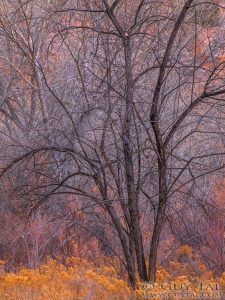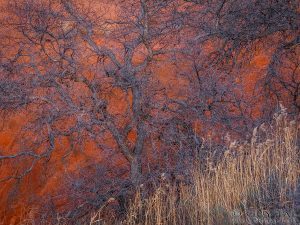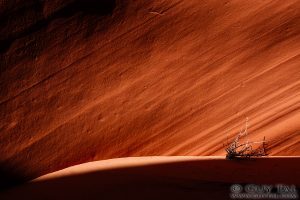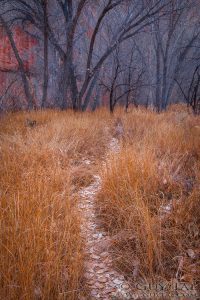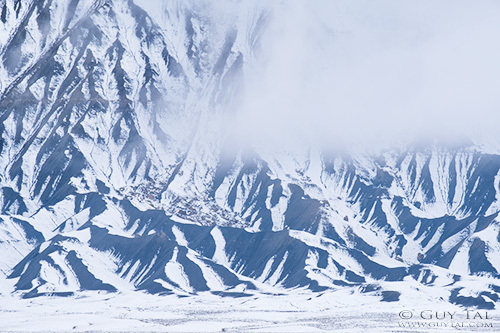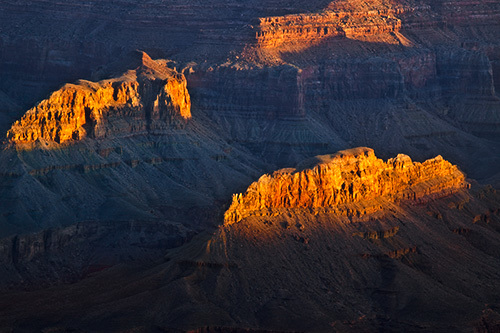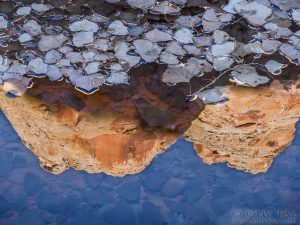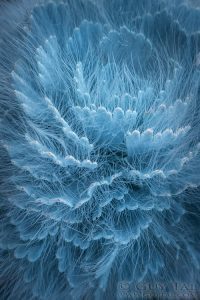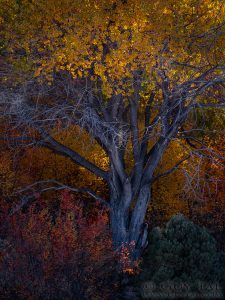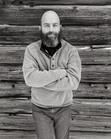Guy Tal's Blog, page 5
March 13, 2018
Proudly Unsponsored
Where solitude ends, there begins the market-place; and where the market-place begins, there begins also the noise of the great actors, and the buzzing of the poison-flies. In the world even the best things are worthless without those who represent them: those showmen, the people call great men. Little, do the people understand what is great—that is to say, the creating agency. But they have a taste for all showmen and actors of great things. ~Friedrich Nietzsche
I have been away from the public eye and the buzz of media for a bit. The reason is not important to the point I wish to make, but it did give me some time to chip away at a backlog of reading, and to listen to a few podcast episodes that lingered in the queue.
On one such podcast, a photographer of some new-found social media notoriety spoke proudly of having secured sponsorships from a number of companies at a trade show, which reminded me that upon being invited to speak at an upcoming event the organizer also asked me if I was sponsored by any companies who may cover my speaking fees in exchange for promotional opportunities.
I have only been tempted to align with corporate brands a couple of times in the past and am not likely to consider it again. Other than my innate resistance to having any “strings attached,” especially when it comes to potentially limiting my ability to speak my mind honestly, what turned me off the most was the inevitability of such arrangements often leading to encounters that to me are too close for comfort with some bureaucrat dedicated entirely to doing the bidding of his or her employer—being “all business,” as the saying goes—a corporate soldier offering no glimpse into his or her being anything other; a human form channeling some corporate creed, ready to promote and to defend its masters’ interests without question and without remorse. Such people, I admit, played a great role in my decision to part ways with the corporate world some years ago.
I don’t begrudge anyone the desire to excel at their job, whether such excellence can be justified by any quality other than the sense of being good at something and being appreciated for it. But admittedly when such desires find expression in an “all business” attitude obscuring the individual, obfuscating whatever identity, empathy, dignity, sense of wonder, and whatever values he or she may possess outside their corporate role; I find that person and that attitude to be incompatible with, if not outright toxic to, the things I care most about in my work.
As stated by Bertrand Russell, “Art springs from a wild and anarchic side of human nature; between the artist and the bureaucrat there must always be a profound mutual antagonism, an age-long battle in which the artist, always outwardly worsted, wins in the end through the gratitude of mankind for the joy that he puts into their lives.” And one may consider the outcomes (perhaps not all bad) of what the absence of such antagonism might lead to: when an artist and a bureaucrat collaborate, and the motives that may drive such collaborations. At the very least such artists, if only in appearance, give up a degree of credibility and freedom of expression, which to me is a cost exceeding whatever benefit I might gain from sponsorship.
And so I am, proudly, unsponsored—an independent explorer (of many things); an unprejudiced ambassador (for wildness and for creative expression); an artist (and not just an artisan). I have to be. Doing what I do, in my mind, is in too many ways not compatible with the motivations of corporations.
Should you wish to chide me that accepting such sponsorships is, “part of the game,” consider that this is not a game to me. It’s my life, and I wish to keep it free of some influences to the degree that I can help it. And should my reluctance to align myself with corporate brands seem worthy to you, consider please that it also means I have to generate income without the business benefits of such sponsorships: by the support of those who appreciate what I do.
February 20, 2018
Landscape Portraits
Every portrait that is painted with feeling is a portrait of the artist, not of the sitter. The sitter is merely the accident, the occasion. It is not he who is revealed by the painter; it is rather the painter who, on the coloured canvas, reveals himself. ~Oscar Wilde
The great painter Henri Matisse described the portrait as “one of the most curious art forms,” requiring not only special qualities in the artist, but also “an almost total kinship with the model.” As an introvert who generally favors solitude over company, my own natural inclination is to distance myself from people rather than to engage with them, and to allow them the same dignity I wish for myself, of private personal space, rather than to point a camera at them.
As a consummate wilderness explorer, most of my travels, by design, take me to places where the trace of humanity is minimal or ostensibly absent. Thus, there are very few people with whom I find the kind of “total kinship” that Matisse described.
Photography, to me, is a medium for creative expression, and by that I mean that my goal as a photographer is to find visual metaphors for my own thoughts and emotions. These thoughts and emotions, for the most part, are inspired by the ways in which I respond to the things I photograph, although at times the things I photograph may also merely be expressive vehicles for things that are entirely unrelated to them. Put another way, my photographic goal is not to portray the appearances of things, places, or people strictly for any objective qualities they may possess, but to use those appearances in order to express something of my own mind.
Human faces prompt me to ponder the thoughts and feelings of the persons they belong to, rather than my own; and while these may interest and move me, it is not their thoughts that I wish to express in my photographic work, but my own.
For these reasons, and with few exceptions, I do not photograph people. I do, however, still make portraits.
Painter and educator Robert Henri wrote, “An interest in the subject; something you want to say definitely about the subject; this is the first condition of a portrait.” And indeed, I feel I have a great interest and much to say about my subjects; it just so happens that my subjects are not people. Taking the liberty of decoupling portraiture from the requirement for human subjects, a portrait, to me, is an intimate and revealing view into those features of a subject that are most expressive, distinctive, and nuanced: the properties that make the subject unique, dignified, interesting, and complex—to me. By that definition I consider much of my work as portraits of the landscapes that inspire me.
In my work, I do not seek to make the landscape identifiable. I do not wish to limit my viewers’ impressions of the places I photograph to just their objective, literal, appearances, nor to their commonly known names, geographic locations, or other data that are irrelevant to my expressive intent. I also don’t wish to glorify the landscape for the sake of aesthetic appeal alone. To my way of thinking, a true portrait should not be an image of someone or something, but an image about someone or something—their inner beauty, the things they symbolize and inspire in me, the traits they reveal only to those who have earned the privilege of their trust, and the nature of my relationship with them. And so, the places I prefer to photograph are ones with which I feel a connection, having visited with them many times, explored them in earnest, and witnessed their many moods. They are not just attractive models to me, but in a sense also friends and sanctuaries and refuges—places I go to not only because they are beautiful or otherwise photogenic, but because I feel comfortable and inspired in them; and it is these qualities that I hope to express in my portraits of them.
Distinct from people, places have no literal personalities, minds, or egos of their own, and so my portraits of the land are, to a substantial degree, self-portraits: projections and reflections of my own thoughts, liberated from the constraint of my own appearance and allowed to inhabit an independent visual form. And I can do so without concern for offending someone else’s view of themselves, or their own desire to appear in any certain way. And so, much like the author of a story, I also can assign personalities, thoughts, and moods to the places and things I portray in my photographs.
My goal in photographing the landscape in intimate and personal ways seems to me to be one that some human-portrait photographers may share as well: not only recording objective beauty, making a sale, or as a common interest around which to socialize with fellow photographers, but also as a means of expression and exploration, of both subject and self.
In many ways, making portraits of the land is also a good way of being introduced to it, and introducing yourself to it. A short-lived encounter may yield a superficial impression, but just as with human subjects, as familiarity, comfort, and trust increase over time, portraits begin to reveal more nuanced dimensions.
Images of random, unfamiliar, subjects reveal something about these subjects, but as the connection deepens, portraits show more of the photographer and more of the nature of the relationship he or she shares with the person or place photographed. Among the finest examples of this progression, in my opinion, is Eliot Porter’s portfolio of Glen Canyon, featured in his book, “The Place No One Knew.” Porter, a pioneer of intimate landscape photography, knew very little about the canyon country of the Colorado Plateau when he was asked to photograph one of its most striking features—Glen Canyon—before it was sacrificed in order to establish what today is “Lake” Powell reservoir, stretching into parts of Utah and Arizona. Describing his first encounter with the place, Porter wrote, “So powerful was the impression, I didn’t know where to look, what to focus on; and in my confusion, photographic opportunities slipped by. I always seemed to be photographing the wrong things… I knew that what I had photographed was a superficial record, the slightest vision of this wonderful place.” And so, he returned to Glen Canyon several more times, each time becoming more intimately familiar with its hidden secrets. After several visits, he established a personal relationship with, and appreciation for, the place that resonates in his later writings. About one of the canyon’s features, he wrote, “Cathedral in the Desert was the single most spectacular place I visited—to me it epitomized the very heart of the southwestern canyon country.” In a sense, Porter established the same kind of “total kinship” with Glen Canyon that Matisse suggested was needed by one who paints the portrait of a human model.
When I make a portrait of a place, I declare its importance to me as a person and as an artist, and express why, to me, it is, as the saying goes, “more than just a pretty face.” Introversion is a trait often leading to a sense of isolation, as those who possess it often feel left out (most often, by choice) of much discourse and social rituals that other artists may better leverage or engage in. It is my hope that those who share my personal inclination for introversion and reclusion also find in my work some validation and acknowledgement that a sense of kinship and profound emotion are also possible in solitude, and not just with human subjects.
February 17, 2018
The Healing Landscape
I seek out places where it can happen more readily, such as deserts or mountains or solitary areas, or by myself with a seashell, and while I’m there get into states of mind where I’m more open than usual. I’m waiting, I’m listening. I go to those places and get myself ready through meditation. Through being quiet and willing to wait, I can begin to see the inner man and the essence of the subject in front of me. ~Minor White
Most images presented as photographs of the natural landscape are, in fact, not made in the natural landscape. Rather, they are made at the edge of it, where it meets the artifice of the human-made landscape—from roads and well-used trails, within easy reach of comforts and services—the edge delineating us from it: the wild. Such images portray the appearance of the landscape—its veneer, its skin—same as the portrait of a person’s face made by one who possesses no deep familiarity with that person. But beyond the skin there also exists a body and a life filled with great strength and great tenderness, great joys and great sorrows, great beauty and sometimes great tragedies. It is a body we once inhabited, and to which we evolved to respond in visceral, emotional ways.
Just as a well-made portrait hints of the life that inhabits a person, so can portraits of the natural landscape offer a glimpse into the depth and drama of its story, and arouse instinctive notions from far recesses of our brains—those places that remain wild and that are often consciously suppressed to accommodate demanding careers and urban lifestyles. But no portrait—of human or place—can substitute for personal acquaintance, for friendship forged over time by a history of intimate encounters, for interactions and shared experiences. It is this kind of kinship, and its familiar sensations, that I seek with my subjects.
The natural landscape is far older, more complex, and more mysterious than I can hope to know, let alone fully understand, within the blink of the lifetime given me. But as an artist this is a realization I cherish as it culminates in the greatest mysteries of existence and offers me a sense of my place in it—a profoundly humbling one. It is a realization that assures me that there will always be more to know, more to feel, more to discover and learn, and more to feed my inspiration. It tells me that I will never run out of interesting and exciting things to immerse myself in and that I can put to use in my photographs, so long as I am willing to keep exploring. And such things to me are not merely of aesthetic value; they also make my life richer; they not only appeal to my sense of beauty, they also console me in difficult times, and inspire life lessons and revelations; and they allow me to share in their experiences as my small thread in the tapestry of existence intersects with theirs, however briefly.
As so many are born and raised in cities, without direct contact with natural things, it may seem perplexing that such feelings seem intuitive even to those who rarely, or never, spend time in wild places. Indeed, studies in recent years reveal that we are innately programmed to respond in specific ways to certain natural phenomena—views and colors and life—in predictable ways. In a sense, such phenomena act as nearly-universal metaphors for some of our deepest and most powerful emotions, often transcending commonality in culture or language. Mired as we are in manufactured and virtual worlds, we still possess instincts infused in us during eons in which our Pleistocene ancestors depended on wild instinct and wild lands for survival and prosperity, offering existential and social advantages to those who evolved intuitive affinity with certain natural configurations that became metaphors for safety, sustenance, challenge, and mystery.
Among the more interesting scientific findings of recent years are those arising from studies showing a general preference for natural scenes that share visual characteristics with the African savanna, where early humans evolved. One study even showed an innate and universal appreciation of trees in the shape of acacias—a dominant tree on the African savanna. Brain imaging technology shows that viewing some types of landscapes is correlated with activity in the brain’s reward system—they give us pleasure just by seeing them. Today, these sciences are still nascent, but there are good indications that certain visual experiences are associated with much more complex perceptions and emotional responses that we do not yet fully understand.
But beyond just visual appeal, the natural landscape inspires emotions in far more diverse and complex ways. Silence, natural sounds, natural scents, natural colors, and natural textures all collaborate to make experiences ranging from simple appreciation of beauty to outright transcendence. It is why, once certain barriers of cognition and skill are overcome, the experience of being in a wild landscape, away from the buzz of the human hives, often leads to elevated, even mystical sensations of being intensely alive.
Such are the things that draw me into the wild and that I hope to express, however inadequately at times, in my work. No image can substitute for a real experience, but in understanding how natural aesthetics may correlate with actuation of certain feelings, even in people who have never experienced wildness before. Such visual cues may be deliberately employed in art as visual metaphors, conveying richer aesthetic experience than merely appreciating the beauty or magnitude of a given scene or object.
I would be remiss to not also mention that my experiences in the wild are not intended primarily as means for making photographs, or anything else. They are worthy to me in their own right (in fact, considerably more so than any photograph I might bring back). My photography and writing, inspired by such experiences, are indeed welcome byproducts, but they are not the main reason I am drawn to these places. Regrettably, this is a notion often lost in the competitive—and at times narcissistic—culture inspired by virtual socializing.
A particularly poignant study conducted in 2012 by psychologist David Strayer of the University of Utah established that spending just four days in wild natural surroundings, and in disconnect from technology, resulted in an astounding 50% increase in participants’ creative problem solving skills. The same study also proposed that too much time spent among the distractions of the virtual world may be detrimental to the functioning of what is known as the brain’s “default mode network,” which is thought to be associated with a number of psychological disorders, and perhaps even with degenerative brain diseases.
The natural landscape offers more than just innate metaphors for obsolete emotional associations; it can also be—in a real and measurable sense—therapeutic, and conducive to a more meaningful life.
January 15, 2018
The Value of Originality
The following article was originally published in LensWork Magazine.
If you do not express your own original ideas, if you do not listen to your own being, you will have betrayed yourself. Also, you will have betrayed your community in failing to make your contribution. ~Rollo May
It is rare that I find reason to disagree with Minor White, but a statement he made in what was to be his last interview, in 1976, gave me pause. When asked by interviewer James Danziger about the dilemma facing young photographers whose work may be too similar to that of their better-known predecessors, White responded: “At this time in the history of photography, everything has been done. All the novelties have been done … All we have to look for now is, as a picture, does it move my heartstrings? If it does, why should I condemn it just because it happens to look like something Weston did?” Today, forty years later, the suggestion that everything in photography has been done by 1976 surely seems as shortsighted as it likely was then to proclaim that everything has been done by, say, 1936. But more intriguing is the question: if a photograph is successful in evoking an emotional response in viewers, should it matter whether it is original or not? I propose that it does, if not unequivocally, at least in some important ways.
Preempting an obvious question, there is no denying that we all stand on the shoulders of giants. To expect one to create entirely original work—free of any and all influences—is hardly realistic, if not outright impossible. Originality, to be sure, is a matter of degree. However, it is hard to argue that photographers standing shoulder-to-shoulder at some well-known overlook aiming to capture near identical compositions of the same view, are much less concerned with originality than those who deliberately pursue novel expressions, subject matter, or styles.
Oscar Wilde proposed that imitation is “the sincerest form of flattery that mediocrity can pay to greatness.” And I find it very telling that so many who quote Wilde choose to omit the latter part of his statement. If true, it also cannot be ignored that, among artists, photographers perhaps “flatter” each other more than any other group. Photographs known to be cover versions and repeat performances not only are frequently made with little critical response and presented with no attribution to anyone other than the photographer; they also often win awards, or are entered into prestigious publications and exhibitions. It is hard to imagine this happening with copies of masterpiece paintings or with plagiarized writings. In music, virtuous performances of known works are revered, but still no performer is likely to be taken seriously if he or she did not also credit the original composer for the score or the lyrics.
The fatal flaw in disregarding the importance of originality, in my opinion, is in placing disproportionate value on the aesthetic appeal of the resulting image, to the detriment of the photographer’s inner experience in the process of making it. All considerations of art and value aside, studies show that creative expression is correlated with states of happiness and satisfaction. Other studies suggest that the production of creative work activates parts of the brain known as the default mode network, whose functions are associated with psychological health in general. In particular, becoming immersed in creative work is conducive to the state of flow, described by psychologist Mihaly Csikszentmihalyi as, “the state in which people are so involved in an activity that nothing else seems to matter; the experience itself is so enjoyable that people will do it even at great cost, for the sheer sake of doing it.” Csikszentmihalyi explains, “Because optimal experience depends on the ability to control what happens in consciousness moment by moment, each person has to achieve it on the basis of his own individual efforts and creativity.”
I believe that creativity and originality are most important not as conditions for art, or for any bearing they may have on the perceived value of an image or other product, but rather in elevating the emotional and intellectual experience of the person making the art.
January 3, 2018
Twenty Seventeen
As to careers, they are vaguer than ever before. I am not as sure that I am an artist. I might try writing my adventures, but the personal element makes that very difficult. I could never endure any position with routine, regular hours, and monotonous work. Unless I am having new experiences, broadening horizons, some sort of change, I cannot feel that life is worth living. I can’t say I’ve ever met anyone whom I could really envy, unless it was Edward Weston. ~Everett Ruess
As in past years, I sit to write this post pondering the significance of the ending of 2017. There isn’t one, for me. Or, at least there isn’t one founded in any meaningful milestone or other consequential event in my life or work. But, as I realized in past years, pausing to reflect on the events of a full year is good in itself, and seems especially worthy when shared alongside similar reflections by many of my colleagues.
It may seem trite to say that 2017 had been a tumultuous and unpredictable year. Indeed, if this was not the case I would consider it reason for alarm. Borrowing from Nietzsche, “is life not a thousand times too short for us to bore ourselves?” (with benign and predictable things).
Recovering from a prolonged illness has been a particularly interesting (and at times decidedly miserable) experience, but it is hard to describe the sense of awakening and the realization that this episode is now in the past. In the midst of it, it became difficult to even remember what it was like to not be sick, to not feel constantly jaded and depressed. I did not anticipate the relief of feeling like I woke up from a long nightmare to realize that my faculties remain; that my ability to sense, to appreciate, to feel inspired and creative, were merely dormant but are still intact; to realize that I am still in there.
I did not go as far or as frequently into the backcountry in 2017 as I have in previous years—a result of overcommitting myself to various deadlines, and of being decidedly out of shape due to my illness. 2018 will be similarly busy, but the lesson was learned. I realized, not for the first time, the truth in Socrates’s admonition: “beware the barrenness of a busy life.”
Despite unforeseen health-related delays, I am particularly proud to have released my new book, The Landscape Photographer’s Guide to Photoshop / A Visualization-Driven Workflow. A couple of new book projects beckon and I look forward to immersing myself in writing again.
I continue to contribute regularly to two of my favorite magazines—LensWork and On Landscape—and hope photographers continue to support these and similar fine publications to keep them advertising-free and content-focused.
As seems to be the tradition, I hope you enjoy a selection of images made this past year, in no particular order or theme.
May the new year be exciting, unpredictable, productive, and enlightening!
December 22, 2017
Vision and Life Interview
My thanks to Mirko Vecernik for his patience and for featuring an interview with me on his new web project, dedicated to inspiration: Vision and Life. I look forward to see how it evolves.
December 21, 2017
Knowledge and Imagination
Intelligence, imagination, talent, and creativity will get nowhere without a basis of knowledge and skills, and for this education must be sufficiently structured and focused. But an education too rigid, too formulaic, too lacking in narrative, may kill the once-active, inquisitive mind of a child. ~Oliver Sacks
Albert Einstein may be the quintessential genius of our age. His insights propelled humanity into realms of understanding that were previously not only unknown, but unimagined. But, Einstein was not immune from making mistakes, and, true to the magnitude of his intellect and insights, some of his mistakes were quite profound, too.
Those in the know likely recall Einstein’s fumble of the cosmological constant, and his refusal to accept Georges Lemaître’s early thoughts on what we know today as the Big Bang theory and the expanding universe, which Einstein did not believe in at the time. Einstein famously told Lemaître, “Your calculations are correct, but your physics is atrocious.” Edwin Hubble later proved that Lemaître was correct and Einstein was wrong.
Perhaps most bitter among his errors was Einstein’s uneasy relationship with quantum mechanics, which may be understandable as quantum mechanics not only cast doubt on Einstein’s belief in a deterministic universe, but also dealt him some mocking and ironic insults. Einstein’s famous quip, “God does not play dice with the universe,” emerged out of his skepticism toward quantum mechanics. Einstein believed that the universe and its workings are a fixed quantity, governed by mathematical laws which, if one was to decipher all of them, would allow perfect knowledge and the ability to predict outcomes with perfect accuracy. Quantum mechanics—the most accurate science ever to be developed by humanity—indeed shows that the universe is governed by mathematical laws, as Einstein hoped, but in a bitter rebuke of Einstein’s determinism, these mathematical laws appear to not return singular answers. Instead, they return probabilities. Randomness, it appears, is encoded into the very laws of physics, which also outright prohibit one—no matter how intelligent or knowledgeable—from knowing everything.
If Einstein’s blunders about quantum theories were not embarrassing enough, consider that he won the Nobel prize not for his seminal signature work on Relativity, but for his contributions to… quantum mechanics—contributions resulting, among other things, from his desire to disprove it. As it turns out, God does play dice… with everything… all the time. In fact, if that was not the case, material existence would not be possible—the fact that matter even exists as we know it, from the grains of sand we walk on to our own bodies, all the planets, stars and galaxies, and more that we may not yet know, is owed to random and unpredictable fluctuations.
Without taking away from so many brilliant philosophical analyses of such things as the “human condition” and other forms of collective navel-gazing explored by philosophers, I believe that the most profound philosophical contemplations yet to be articulated are those arising out of quantum mechanics. Indeed, it is possible that such philosophy may turn out to exceed the limits of our intellect and imagination. This brings me to the point of this article, which is this: although I accepted it as a truism for many years, I have come to believe that another of Einstein’s often quoted aphorisms—”Imagination is more important than knowledge”—is also rooted in error.
That knowledge—even what relatively little of it we possess—exceeds the limits of our cognitive ability to imagine, should have been clear to Einstein as much as to anyone else. His knowledge of mathematics and Newtonian physics, helped to a degree by imagination, led him to discoveries never imagined before him, and showed that the nature of reality exceeds in spectacular ways the limitations of human imagination.
Quantum mechanics pushed the boundaries of knowledge, and our acknowledgment of the limitations of human imagination, even further—much further—than Einstein’s principles of Relativity. In contemplating the nature and implications of such things as wave/particle duality, quantum superposition, or the Uncertainty Principle, not only do we find ourselves lacking the means to grasp what we already know from experiments, but also in our ability to imagine what these scientific insights tell us about the nature of existence. Indeed, anything previously imagined about such things pales in comparison with what we learned and now know to be true.
Richard Feynman made a similar observation, writing, “It is a great adventure to contemplate the universe beyond man, to think of what it means without man—as it was for the great part of its long history, and as it is in the great majority of places. When this objective view is finally attained, and the mystery and majesty of matter are appreciated, to then turn the objective eye back on man viewed as matter, to see life as part of the universal mystery of greatest depth, is to sense an experience which is rarely described. It usually ends in laughter, delight in the futility of trying to understand.” A Nobel-winning physicist himself, Feynman also conceded, “Will you understand what I’m going to tell you? … No, you’re not going to be able to understand it. … That is because I don’t understand it. Nobody does.”
Einstein was a proponent of thought experiments, so I’ll suggest one to illustrate my point: stretch your imagination as far as you can and see if you can come up with something more mysterious, bizarre and astounding than demonstrable (albeit still profoundly lacking) knowledge about such things as the magnitude of the universe or such phenomena as quantum entanglement (called “spooky action at a distance” by Einstein in yet another embarrassing demonstration of his failure to acknowledge quantum mechanics).
Consider what we regard as the great natural beauty, diversity, and majesty of just the ordinary planet we live on, so much of which is still unknown to us, and try to imagine the implications and mysteries of the undisputed existence of trillions upon trillions of other planets and worlds, many far larger than our Earth, in just that limited realm of material existence we regard as the known universe.
Let this not lead you to believe that I am suggesting that imagination is of little importance or use. My point is just to place imagination in context—to offer an understanding of the immense magnitude of the difference—between imagination and knowledge.
Imagination indeed is a powerful and useful catalyst for the acquisition and expansion of knowledge, but knowledge fuels imagination much more than imagination fuels knowledge. Every level of knowledge only allows so much in the way of imagination. Expand knowledge, and you also expand the boundaries of what can be imagined. But, let us not brush aside the fact that knowledge has revealed to us things spectacularly grander, more complex and more mysterious than our “highly-” (graded on a curve arbitrarily and ironically representing just what we know) evolved brains are even capable of coping with.
~~~
I was recently asked to offer “a word of advice for fellow artists,” which, as a thought exercise, I decided to take literally. My word of advice is this: read.
Even a basic knowledge of such things as natural history, geology, cosmology, chemistry, and physics, will unleash greater awe and inspire more meaningful contemplations about the nature of existence than anything you could imagine if lacking this knowledge.
Imagination indeed is a useful tool in prompting creative thought, in encouraging exploration, in improving the living experience… but no imagined existence can come close to the immensity of existence as revealed by what knowledge we have—even as there remains so, so, much we do not yet know, or may never know, or may be incapable of knowing.
In the narrow context of being a self-expressive artist, my work arises out of my experiences; and my experiences, while undoubtedly enhanced by my ability to imagine, benefit most from increasing my knowledge of myself and of the things and places that inspire my work: how they came to be, why they appear to me as they do at this point in time, why they feel to me as they do, the scale of their existence and the magnitude of the forces that shaped them, etc.
Imagination is important, but only insofar as it prompt us to explore in search of knowledge. Imagination is, by a very long margin, not a substitute for knowledge.
To put a finer point on Einstein’s misconception regarding imagination and knowledge, consider that he also said, “knowledge is limited, whereas imagination embraces the entire world.” It is, in fact, (human) imagination that is profoundly limited by the very fact that it is a product of the mind of just a primate at this particular point in the unfolding saga of existence. It is knowledge that, practically speaking, is limitless, as our inability to possess, let alone fathom, even the knowledge accumulated by just our species, to date is beyond the cognitive abilities of any of us. Every leap in scientific understanding reveals to us just how lacking our knowledge is, but even more so, how lacking imagination is for failing to conjure marvels even approaching those we know to be true.
Certainly, I encourage anyone interested in enriching his or her life, to contemplate and to imagine and to seek creative epiphanies. But consider that such cognitive tools as contemplation, imagination, and creativity, are but means to an end—the small vessel that can carry us into the immense ocean of knowledge to be had. In time, and with knowledge, we learn how to improve our vessels of exploration, and venture further still.
Read.
December 20, 2017
November 20, 2017
The Traditions of Photography
This essay was adapted from one previously published in LensWork Magazine.
On the road from fish, bird, and ape to the war-waging animal of our time, on the long road by which we hope in time to become men and gods, it could not have been the “normal” ones that had pressed forward from stage to stage. The normal ones were conservative, they clung to what was healthy and traditional. ~Hermann Hesse
In 1923, photographer Paul Strand wrote an essay for the British Journal of Photography in which he lamented, “… photography has a tradition, although most of those who are photographing today seem to be unaware of the fact.” He then admonished, “… if you want to photograph, and if you are not living on a desert island, look at this tradition critically.” Taking his own advice, Strand then proceeded to berate what at that time was photography’s most prominent tradition, Pictorialism, suggesting, “If you let other people’s vision get between the world and your own, you will achieve that extremely common and worthless thing, a pictorial photograph,” and concluding that the achievement of a worthwhile photograph means that “there are no short cuts, no formulae, no rules except those of your own living.”
Like Strand, I never quite accepted the unquestioning preservation of traditions for the sole reason that they are traditions. In my mind, the way to honor traditions is to remember and to study them, to learn about and from them, to adopt those portions of them that are useful and honorable; but not to blindly insist on keeping alive those that are no longer beneficial or relevant in the context of one’s own life and work.
The reason I mention Strand here, and his essay dating back more than ninety years, is that as I interact with fellow photographers I find that the knowledge of photography’s evolution also separates those who consider themselves “traditionalists” (whether practicing such traditions or having a degree of familiarity with them) from those who pursue photography with the primary goal of recording aesthetically pleasing scenes without regard to the medium’s rich, albeit relatively short, history. With the benefit of having observed both persuasions for some time, I find that there is more to the separation than merely who knows what, and how much.
Much time had passed since Strand wrote his essay. Pictorialism is still practiced by some but is by no means the mainstream doctrine in photography today; and the means of producing photographic images are now more accessible and easier to use than ever. It is worthwhile, I think, to pause and reflect on photography’s traditions in a world that Strand, his predecessors, and his contemporaries likely could not have even predicted—a world of instant gratification, automation, and the Internet—where those who know about photography’s traditions, let alone practice them, are becoming progressively rare.
As I think about what makes one a traditionalist, I realize that the distinction goes deeper than merely the knowledge of some processes, or having an interest in the history of the medium. Indeed, I think that the world of photography has transitioned into new hands. It used to be that photography was the favored avocation of introverts, allowing unquestioned solitary time in a darkroom—a private world behind a closed door where magic unfolded in development trays under the eerie glow of a safelight, and where one could be alone with their thoughts, disconnected from society, without having to explain. The photographer then was an eccentric, an alchemist, an observer. Today’s mainstream photographers seem almost the opposite: bold and outspoken and public; no longer experiencing, observing, and reacting, but planning and executing, broadcasting and marketing not only their photographs and thoughts but also their travels, corporate sponsors, and lifestyles, and even their most trivial accomplishments, to the widest audience they can reach. Most of today’s photographers no longer spend intimate hours processing and printing their work, and often go out of their way to promote tips and tricks and commercial services for minimizing and shortcutting such prolonged and solitary aspects of photography. In a sense, the tradition perhaps most obviously lost is that of finding profound pleasure and value in the photographic process, not to the detriment of the finished image, but as an indispensable and immensely pleasurable means to it.
The worlds of introverts and extroverts are difficult to bridge. One does not fully understand the other and often considers it anathema. And yet, having observed both for some time I lament some of what was lost, not in terms of tradition, but in terms of lessons once learned, and now forgotten or unknown; and which can greatly enrich one’s joy of photography in ways not usually explained or taught in today’s photographic classes and texts.
And so, my advice to those not versed in the traditions of photography is not necessarily to practice them, but to learn the histories and philosophies of those who did. It is hard to explain the value of finding contentment and flow in one’s process to someone who had not already experienced them, or who does not naturally gravitate toward such states of mind. And yet, there is no denying their power. There is more to tradition than mixing chemistry or using certain equipment. Today, photographers no longer are forced to slow down by the nature of the technology available to them, but can still choose to do so and reap the associated rewards.
Beyond the works of contemporary photographers we also have at our fingertips today immense knowledge, ideas and accounts dating back to the invention of photography, and that may be of great benefit, not for tradition’s sake, but so that we may see further from the shoulders of the giants that preceded us, and perhaps give rise to a few giants of our own that will some day empower those to follow to see further still.
November 10, 2017
Don’t (Always) Blame Yourself
We recognize that someone has found their voice when their distinctive spiritual or emotional core becomes an inseparable part of their art. Reaching that threshold means letting the concerns and influences of others fall away, so that your own voice is heard clearly. It takes a whole lot of dedication and conviction and hard work and talent and luck to make that happen—but most of all it takes time. ~Ted Orland
Shortly after the turn of the twentieth century, a 19-year-old cadet named Franz Xaver Kappus, feeling at odds with his military duties and yearning to write poetry, wrote a letter to the great poet Rainer Maria Rilke seeking guidance and encouragement. Rilke initially declined, but ultimately yielded. Rilke’s letters to Kappus, now collected in a book titled, Letters to a Young Poet, offer some of the most articulate, intimate, and insightful advice that anyone with a poetic soul seeking expression may hope for.
Rilke did not limit his responses to unconditional encouragement and empty platitudes. Indeed, much of his advice came in the form of “tough love.” Addressing Kappus’s initial inquiry, Rilke prodded to see if he was truly cut out for the life of a poet and if his imagination and conviction were up to the task. When it came to worthy subjects of poetry, Rilke admonished, “…turning to those that your own everyday life offers you; describe your sorrows and desires, your passing thoughts and your faith in some kind of beauty—describe it all with heartfelt, silent, humble sincerity and use it to express yourself, the things that surround you, the images of your dreams, and the objects of your memory. If your daily life seems poor to you, do not blame that: blame yourself. Tell yourself that you are not poet enough to call forth its riches; because for the creator there is no poverty and no poor and unimportant place.”
I mentioned in previous writings the psychological state of flow, described by psychologist Mihaly Csikszentmihalyi, who wrote, “Contrary to what we usually believe … the best moments in our lives, are not the passive, receptive, relaxing times—although such experiences can also be enjoyable, if we have worked hard to attain them. The best moments usually occur when a person’s body or mind is stretched to its limits in a voluntary effort to accomplish something difficult and worthwhile.” (emphasis added).
I believe that investment of time and intellect in creative work, and daring to tackle challenging and complex tasks with the knowledge that the occasional failure is a real—and ultimately, inevitable—possibility, are indispensable conditions to reaping the greatest rewards that one may get from the practice of photography or any other creative pursuit. I also believe that these rewards cannot be accomplished without considerable investment of time, attention, and effort—not by technology; not by shortcuts, tips and tricks; and not by peer recognition (be it awards, titles, “likes,” or celebrity).
It is often acknowledged that creating good art, and being a good teacher, require skills in art and in teaching, as well as creativity and imagination on the part of the artist or teacher. It is seldom admitted, however, that the same dedication and willingness to invest effort in learning and understanding are needed on the part of the student wishing to create or appreciate art (especially art that aims to be more complex than just “look at this pretty view/thing”) and to get the most out of an educational experience. Similarly, some proclaim to seek a meaningful—dare I say, spiritual—experience in communing with the landscape and/or in expressing their thoughts and feelings in art, but are deterred by minor inconveniences, or come to the experience preoccupied with distractions or prejudices they are unwilling to let go of, and thus fail to find what they sought.
To anyone who is hoping for inspiration, education, or personal insight in art, but who refuses to invest time, labor, or intellectual effort in the endeavor, and instead seeks easy shortcuts, ultimately falling short of his or her desired experience or outcome, my opinion agrees with Rilke’s: blame yourself. You are not poet enough.
However, with no disrespect intended to Rilke, I also believe that blaming yourself when it is unwarranted, especially if ensuing out of a misplaced sense of guilt or unworthiness, may result in discouraging and equally misplaced expectations. Not all frustrations with art ensue out of laziness or demotivation, nor lack of imagination or ability. And not one of us is unworthy or incapable of creative thought or of making meaningful art. It is, therefore, the task of a conscientious educator to not just demand an investment of effort but also to convince those seeking guidance that such investment is worthwhile; that creativity and imagination may at times be suppressed for various reasons, but they are never entirely absent. Like any learned function—whether physical or cognitive—creativity, imagination, and artistic skills can be acquired, improved, and honed through learning and practice.
Too many resources aiming to help photographers advance beyond their current level focus on knowledge and technique, which I collectively refer to as means of expression. But what good are means of expression without having things worth expressing? I believe this is where photography has the greatest power to influence lives—that of the photographer and those of his or her audience. Just knowing how to write will not make you a great writer; just knowing how to run is not enough to complete a marathon; and just knowing how to photograph does not mean that your photographs will be creative and meaningful. Intent, desire, courage, and grit—the ability to keep at it despite failure and resistance—are what makes the difference between someone capable of meaningful accomplishment and someone who just knows about meaningful accomplishments.
If you are among those struggling with finding the “next thing,” don’t blame but rather congratulate yourself! Blame should be reserved not to failure, but to unwillingness to try. So long as you believe there is more to be done, to be learned, to be expressed—even if you find yourself in the throes of a creative block, a personal struggle, or in search of meaning yet to reveal itself to you—don’t blame yourself. Keep trying. Take a break, if needed. But don’t give up. Accomplishments are rewarding but the rewards are short-lived. To live creatively, to constantly seek meaningful expressions, to try—those are the things that reward every single day.

